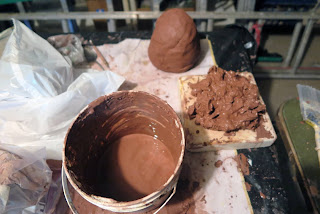After finishing a number of small sculptures in the shape of chairs, I turned once again to the barrels of unused locally harvested orange clay of the Edisto River basin. This had been percolating under wraps in large white spackling buckets in the corner of my studio for about four years. Picking up where I left off four years ago, I began to make the anthropomorphous animal shaped ceramic musical bells that I had previously named The Sonic Hedgehogs. What emerged became the Orangeburg Pit Players. These were initially meant only to serve as novelty items, but after I accumulated a number of them and began to play with them, they became destined for something more.
For a start, I’ll outline the labor-intensive process by which these are born. Most of them function as primitive bells. The sound of the bell is made by a solid ball, known as a katel, hitting the sides of a hollow sphere when shaken. The pitch of the sound is determined by the length and width of the opening of the round sphere.
The first step in making these bells is to create the separate parts of the instrument portion of the figure: the hollow sphere and the solid ball, or katel. It is wise to allow more drying time for the solid katel than the two parts of the sphere that will house it, so that it does not adhere to the sides during assembly. Made by hand, the sphere is basically two small pinch pots that can be sealed together.
When the katel is sufficiently hardened, it is placed inside one side of the sphere. The edges of both sides of the sphere are scored and slip is applied. The two pieces are then sealed together with the katel inside.
When it is nearly leather hard (not yet completely dry but no longer pliable) a gash or hole is made in one side of the sphere. Then attachments are added to the sphere in patterns or designs that rough out the shape of the final figure. Two of the figures here, are hollow with holes and a fipple added to make them into small flutes rather than bells.
After the attachment dry to nearly leather hard, the forms are carved to refine the details.
The figures are allowed to dry thoroughly, then further refined with fine sandpaper and smoothed with moist rags.
To emphasize the details, I then add a mixture of water and black iron oxide.
For coloring, I use a commercial underglaze mixed with painting terra sigillata. This is then burnished smooth by hand and with small stones and metal tools.
Some artists do a pit firing at this point, which blackens portions of the sculpture for an antique look. I low fire bisque them first in order to ensure some solidity and stability to the clay.
After the bisque, I pit fire the pieces. Results vary depending upon the temperature the fire reaches and the degree of reduction in the firing (removal of oxygen). For large loads, I use an old defunct kiln loaded with wood. The firing can take the greater part of a day. For smaller, quicker loads, a coffee can will do. I smother the fire with Spanish moss and grass. A lid goes on the kiln. The coffee can gets covered with an overturned ceramic bowl.
After the kiln cools (two days for the large one, and about five hours for the can) the pieces are removed, cleaned and dried. The sheen sometimes disappears with higher temperatures but can be reclaimed with a thin coat of microcrystalline was and buffed to a satin glow.
Some of the higher temperature firing results in an iridescent effect. A lot of work for such small delights!
























































